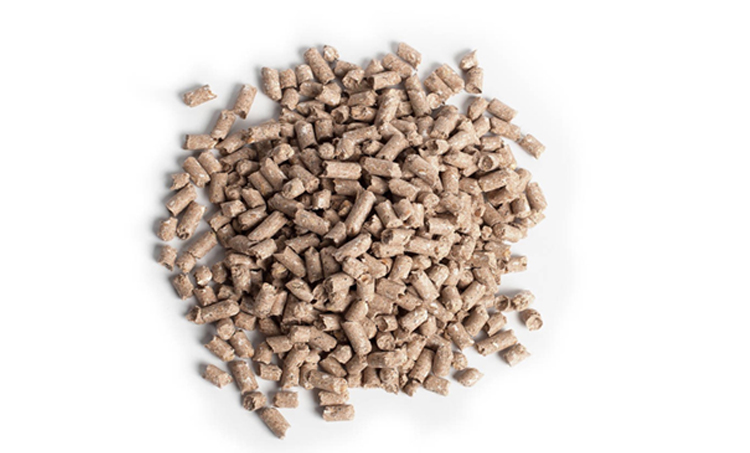2022-02-25

プロセスの設計と運用技術、および飼料プラントのその他の問題により、最終製品の品質と生産量が期待される要件を満たすことができません。粒子表面は滑らかではなく、粉末率が高く、壊れやすく、不均一などです。実際の分析によると、ペレット化の利点に影響を与える主な理由は次のとおりです。
原材料
でんぷん含有量の多い素材は、糊化しやすいです。これらの原材料は、コンディショニングと焼き戻しの後、粘着性があり、成形に役立ちます。粗繊維の多い原料はリング型の摩擦を大きくするため、金型を通過しやすくするために一定量のグリースを添加し、完成品の表面を滑らかにします。ペレット化プロセスから、粉砕が細かすぎる場合、ペレット化の強度が増加します。破砕が粗すぎると、リングダイとローラーの摩耗が大きくなり、成形が困難になり、歩留まりが悪くなり、粉体率が高くなります。したがって、異なる材料は異なる研削直径を使用する必要があります。家畜や家禽の飼料には、トウモロコシの粉砕に2.5〜3mmのふるい板をお勧めします。さらに、異なる原材料、異なる処方、混合時間も異なります。造粒する前に、混合係数が約5%に達するように、混合の均一性に注意する必要があります。
給餌制御
生産効率が低くなると、多くの飼料工場はペレット化の問題のみを考慮し、入ってくる材料の管理を無視します。実際には、供給流量はペレット化速度に直接影響します。このとき、供給の流れが不安定であるかどうかを調べ、原因を調査し、供給時の断続的な状況を効果的に排除し、ペレットミルが停止しないようにし、均一かつ完全に負荷がかかるようにする必要があります。
生産オペレーション
ペレットミルの部品を正しく調整してください。リングダイとローラーのスペースは、小さすぎたり大きすぎたりすることや、ノイズや材料のペレット化に影響を与えることを避けるために、通常0.05〜0.30mmに制御されます。スクレーパーの上端曲線とリングダイおよびリングダイカバーの間のギャップは、基本的に2〜3mmに制御されます。ペレットミルを開き、ダイからペレットがスムーズに出ているかどうかを観察し、現在の変化に注意してください。機械内の雑貨がリングダイに侵入するのを防ぐために、操作ドア上の機械の排出ドアを開き、機械内の雑貨と混合した物質を排出する必要があります。破片の材料が洗浄された後、材料はリングダイにインポートすることができます。
リングダイ
材料とダイ壁の間の摩擦係数、含水率、原材料のサイズ、温度、材料の可塑性、材料の圧縮率など、これらすべてが材料に影響を与え、ダイからスムーズに取り出すことができます。これらは、リングダイの開口と穴の深さに密接に関連しています。ダイ穴を1:8〜1:13(つまり、ダイ穴とダイの有効厚さ比)で圧縮することをお勧めします。圧縮比が小さすぎると、時間の開口部を通る材料が短く、効率は高くなりますが、緩みやすく、表面の滑らかさが低くなります。逆に、圧縮穴の有効長が長いほど、材料の圧力が高くなり、完成品の気密性が高くなります。しかし、生産量は減少し、エネルギー消費量は増加します。したがって、ユーザーは自分のニーズに応じてリングダイの圧縮比を選択できます。家畜および家畜の飼料材料の場合、リングダイの圧縮比は一般に10未満であり、水生飼料の場合、リングダイの圧縮比は一般に10を超えます。

Due to process design and operation technology and other problems in feed plant, resulting in the quality and output of finished products can not meet the expected requirements. The particle surface is not smooth, with high powder rate, fragile, and uneven etc. Through practical analysis, the main reasons affecting the benefit of pelleting are as follows.
Raw material
The material with high starch content is easy to be gelatinized. These raw materials, after conditioning and tempering, are sticky and conducive to forming. The raw material with high crude fiber increases the friction of the ring mold, so a certain amount of grease should be added to facilitate the material to pass through the die hole, and the surface of the finished product is smooth. From the pelleting process, if crushing is too fine, the strength of pelleting is increased; If crushing is too coarse, the wear of ring die and roller is increased, and makes the forming difficulty, resulting in low yield, high powder rate. Therefore, different materials need to use different grinding diameters. For livestock and poultry feed, 2.5-3mm sieve plate is recommended for crushing corn. In addition, different raw materials, different formula, the mixing time is also different. Before granulation, mixing uniformity should be noticed, so that the mixing coefficient reaches about 5%.
Feeding control
When the production efficiency becomes low, many feed mills only consider the pelleting problem and ignore the control of incoming materials. In practice, the feed flow rate directly affects the pelleting speed. At this time, it is necessary to find out whether the feed flow is unstable, so as to investigate the cause, effectively eliminate the intermittent situation when feeding, ensure that the pellet mill does not stop, uniformly and fully load works.
Production operation
Adjust the parts of the pellet mill correctly. The ring die and roller space is generally controlled at 0.05-0.30mm, to avoid too small or too large, and noise and affect the material pelletizing. The gap between the upper edge curve of the scraper and the ring die and the ring die cover is basically controlled at 2~3 mm. Open the pellet mill, observe whether there are pellet out of the die smoothly, pay attention to the current change. In order to prevent sundries in the machine from entering the ring die, the discharging door of the machine on the operating door should be opened, and the material mixed with sundries in the machine should be discharged. After the debris material is cleaned, the material can be imported into the ring die.
Ring die
Friction coefficient between material and die wall, moisture content, raw material size, temperature, material plasticity and material compressibility, etc., all these affect the material can be smoothly out of the die. These are closely related to ring die aperture and hole depth. It is recommended that the die hole be compressed at 1:8 ~ 1:13(i.e. the effective thickness ratio of die hole to die). If the compression ratio is too small, the material through the aperture of the time is short, and efficient is high, but it is easy to loose, and with low surface smoothness. On the contrary, the longer the effective length of the compression hole, the greater the material pressure, the higher the tightness of the finished product. But the output declines, the energy consumption will increase. Therefore, users can choose the compression ratio of the ring die according to their own needs. For livestock and poultry feed material, the ring die compression ratio is generally less than 10, and for aquatic feed, ring die compression ratio is generally more than 10.
著作権 © 江蘇良友正大株式会社 版権所有 FDSPは、専門の製造業者の専門の飼料機械、肥料機械、バイオマス機械、鋼鉄サイロエンジニアリングです